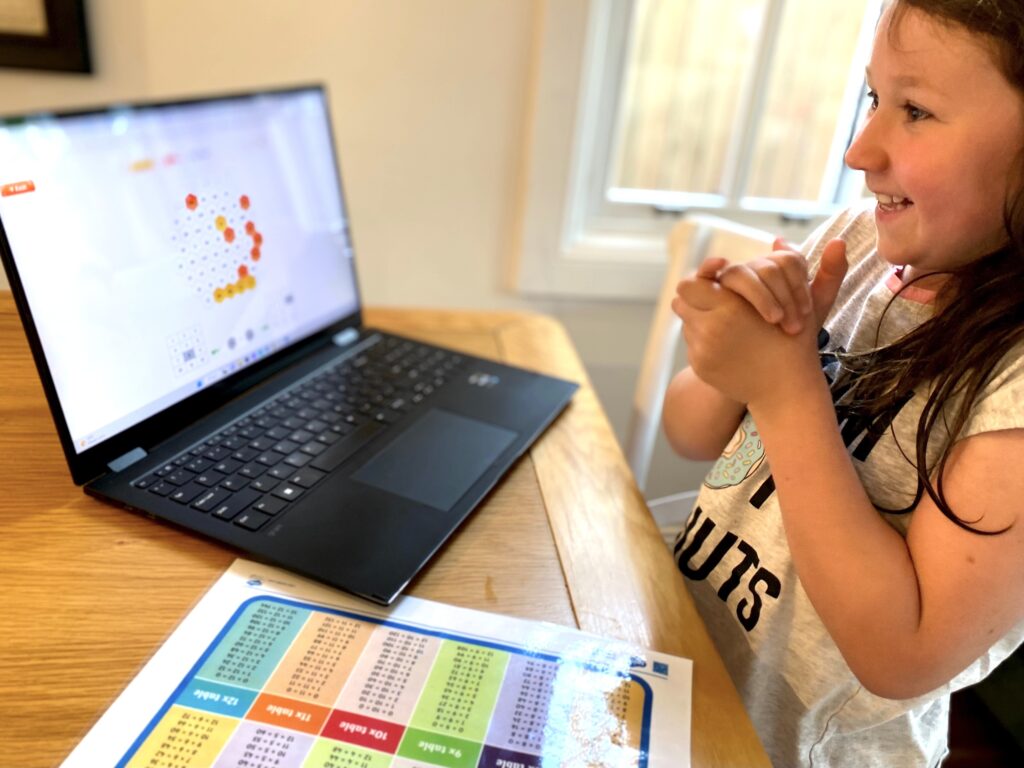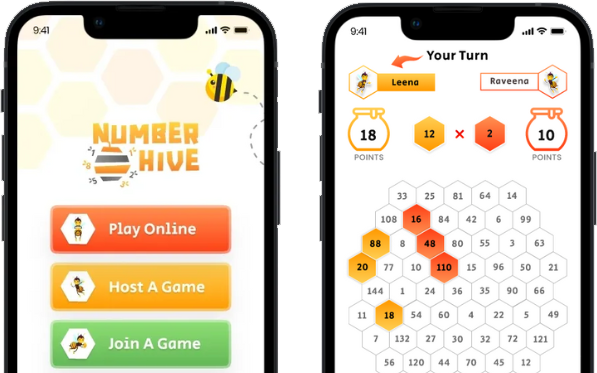
Teaching multiplication younger yours children is an essential step in building a strong foundation in mathematics. By mastering these facts, students gain the necessary skills to solve more complex mathematical problems with ease.

In this blog, we will explore practical tips and strategies to help teachers effectively teach multiplication facts to their young learners. We will also introduce an engaging game called Number Hive, which can be used as a valuable resource to reinforce multiplication skills. Whether you’re looking for interactive digital tools or printable resources, we have you covered!
5 teaching tips
1: Start with Concrete Manipulatives:
Young children learn best when they can see and manipulate physical objects. Begin by introducing concrete manipulatives such as counters, blocks, or small toys. Use these objects to demonstrate the concept of multiplication through grouping and repeated addition. Encourage students to explore and discover patterns on their own.
2: Visual Representations and Arrays:
Visual representations, such as arrays, are powerful tools for helping children visualize multiplication. Create arrays using manipulatives or draw them on paper. Show students how arrays represent multiplication facts and help them recognize patterns. The Number Hive multiplication charts can be a valuable visual resource for students to refer to while practicing.
3: Use the Number Hive Game:
Number Hive is an exciting game that can reinforce multiplication skills in a fun and engaging way. Available on desktop, as a mobile app, or in a printable version, and as mastering number operations is a corner stone of all global curriculum, Number Hive is curriculum agnostic. The game allows students to practice multiplication facts through strategic thinking and gameplay. Encourage students to play individually, in pairs, or in small groups to enhance collaboration and problem-solving skills.
4: Real-World Applications:
Connect multiplication to real-world scenarios to make it more meaningful for young learners. Explore situations where multiplication is used, such as equal groups of objects or sharing items among friends. Engage students in problem-solving tasks that require them to apply multiplication skills in practical contexts. Number Hive offers scenarios within the game that reflect real-life situations, enhancing students’ understanding and application of multiplication concepts.
4: Progress Monitoring:
Regularly assess students’ progress to identify areas of improvement and provide targeted interventions. Use informal assessments like oral questioning, quick quizzes, or observation of students’ problem-solving strategies. Leverage the data from Number Hive gameplay to track individual student performance and identify specific multiplication facts that require further practice.
Teaching multiplication facts to younger children can be an exciting and rewarding journey. By implementing the strategies mentioned above and incorporating the interactive game Number Hive, you can create an engaging learning environment that fosters confidence and understanding in multiplication. Remember to utilize the Number Hive multiplication charts, explore the game’s alignment with various curricula, and adapt the resources to meet the specific needs of your students. Together, let’s empower young learners to become multiplication masters!
Want to give it a try? Here are some lesson plans that will make learning multiplication fun and meaningful. Aligned with local standards (scroll down for more regions), these lesson plans lead to deeper understanding, higher retention, and best of all, it’s kid-approved! So let’s get those little minds buzzing with excitement!
USA – Common Core
| Lesson | Goals | Common Core Standards |
| 1-3 | Lessons 1-3: Introduction to Multiplication – Introduce the concept of multiplication as repeated addition. Use visual aids, such as arrays or counters, to demonstrate the concept. Use our 0-99 grid or 0-149 grid with counters to help students find multiples. Here is an example. – Have students practise solving simple multiplication problems using visual aids. – Have students explore the Times Table chart here looking for patterns. | CCSS.MATH.CONTENT.3.OA.A.1 |
| 4-6 | Lessons 4-6: Basic Multiplication Facts – Review the concept of multiplication as repeated addition.Introduce basic multiplication facts (e.g., 0-5 times tables). – Have students practise solving basic multiplication problems. – Students explore the printout of the Number Hive game board. – They identify and color in multiples of certain numbers. For example, multiples of 5 might be blue. | CCSS.MATH.CONTENT.3.OA.A.1, CCSS.MATH.CONTENT.3.OA.A.2 |
| 7-9 | Lessons 7-9: Strategies for Solving Multiplication Problems – Introduce various strategies for solving multiplication problems, such as the commutative property, skip counting, and using multiplication facts to solve division problems. – Have students practise using these strategies to solve multiplication problems using Number Hive. Select Practice mode and play against the Bot on easy, progressing as they feel confident. Students may consult their multiplication chart as they play but they are encouraged to use skip counting strategies. | CCSS.MATH.CONTENT.3.OA.B.5 |
| 10-12 | Lessons 10-12: Advanced Multiplication Facts – Introduce advanced multiplication facts (e.g., 6-9 times tables). – Have students practise solving advanced multiplication problems using Number Hive. They progress through the levels on practice mode. – Students may now begin to play classmates using the host game. | CCSS.MATH.CONTENT.3.OA.A.1, CCSS.MATH.CONTENT.3.OA.A.2 |
| 13-15 | Lessons 13-15: Review and Assessment – Review all multiplication concepts and facts learned in the previous lessons. – Students play Number Hive in whatever mode they please. – Hold a Number Hive class tournament using the guidelines and poster here. – Students to fill out self-assessment found here. – Provide additional support and instruction as needed. | CCSS.MATH.CONTENT.3.OA.A.1, CCSS.MATH.CONTENT.3.OA.A.2, CCSS.MATH.CONTENT.3.OA.B.5 |
UK
| Lesson | Goal | Standards |
| 1-3 | Lessons 1-3: Introduction to Multiplication – Introduce the concept of multiplication as repeated addition. Use visual aids, such as arrays or counters, to demonstrate the concept. Use our 0-99 grid or 0-149 grid with counters to help students find multiples. Here is an example. – Have students practise solving simple multiplication problems using visual aids. – Have students explore the Times Table chart here looking for patterns. | Year 3: Use the multiplication tables they know to derive division facts (2.6) |
| 4-6 | Lessons 4-6: Basic Multiplication Facts – Review the concept of multiplication as repeated addition.Introduce basic multiplication facts (e.g., 0-5 times tables). – Have students practise solving basic multiplication problems. – Students explore the printout of the Number Hive game board. – They identify and colour in multiples of certain numbers. For example, multiples of 5 might be blue. | Year 3: Recall and use multiplication and division facts for the 3, 4, and 8 multiplication tables (2.5) |
| 7-9 | Lessons 7-9: Strategies for Solving Multiplication Problems – Introduce various strategies for solving multiplication problems, such as the commutative property, skip counting, and using multiplication facts to solve division problems. – Have students practise using these strategies to solve multiplication problems using Number Hive. Select Practice mode and play against the Bot on easy, progressing as they feel confident. Students may consult their multiplication chart as they play but they are encouraged to use skip counting strategies. | Year 3: Identify and describe the properties of prime, square, and composite numbers (2.7) |
| 10-12 | Lessons 10-12: Advanced Multiplication Facts – Introduce advanced multiplication facts (e.g., 6-9 times tables). – Have students practise solving advanced multiplication problems using Number Hive. They progress through the levels on practice mode. – Students may now begin to play classmates using the host game. | Year 4: Recall multiplication and division facts for multiplication tables up to 12 × 12 (2.5) |
| 13-15 | Lessons 13-15: Review and Assessment – Review all multiplication concepts and facts learned in the previous lessons. – Students play Number Hive in whatever mode they please. – Hold a Number Hive class tournament using the guidelines and poster here. – Students to fill out self-assessment found here. – Provide additional support and instruction as needed. | Year 4: Use place value, known and derived facts to multiply and divide mentally, including: multiplying by 0 and 1; dividing by 1; multiplying together three or four numbers (2.6) |
Australian Curriculum
| Lesson | Goal | Standards |
| 1-3 | Lessons 1-3: Introduction to Multiplication – Introduce the concept of multiplication as repeated addition. Use visual aids, such as arrays or counters, to demonstrate the concept. Use our 0-99 grid or 0-149 grid with counters to help students find multiples. Here is an example. – Have students practise solving simple multiplication problems using visual aids. – Have students explore the Times Table chart here looking for patterns. | Year 3: Use concrete objects, pictures and arrays to represent multiplication and division situations (ACMNA041) |
| 4-6 | Lessons 4-6: Basic Multiplication Facts – Review the concept of multiplication as repeated addition.Introduce basic multiplication facts (e.g., 0-5 times tables). – Have students practise solving basic multiplication problems. – Students explore the printout of the Number Hive game board. – They identify and colour in multiples of certain numbers. For example, multiples of 5 might be blue. | Year 3: Recall and use multiplication and division facts for the 2, 5 and 10 multiplication tables (ACMNA042) |
| 7-9 | Lessons 7-9: Strategies for Solving Multiplication Problems – Introduce various strategies for solving multiplication problems, such as the commutative property, skip counting, and using multiplication facts to solve division problems. – Have students practise using these strategies to solve multiplication problems using Number Hive. Select Practice mode and play against the Bot on easy, progressing as they feel confident. Students may consult their multiplication chart as they play but they are encouraged to use skip counting strategies. | Year 3: Recognise and describe common factors, common multiples and prime numbers (ACMNA043) |
| 10-12 | Lessons 10-12: Advanced Multiplication Facts – Introduce advanced multiplication facts (e.g., 6-9 times tables). – Have students practise solving advanced multiplication problems using Number Hive. They progress through the levels on practice mode. – Students may now begin to play classmates using the host game. | Year 4: Recall multiplication and division facts for multiplication tables up to 10 × 10 (ACMNA048) |
| 13-15 | Lessons 13-15: Review and Assessment – Review all multiplication concepts and facts learned in the previous lessons. – Students play Number Hive in whatever mode they please. – Hold a Number Hive class tournament using the guidelines and poster here. – Students to fill out self-assessment found here. – Provide additional support and instruction as needed. | Year 4: Use place value, known and derived facts to multiply and divide mentally, including: multiplying by 0 and 1; dividing by 1; multiplying together three or four numbers (ACMNA049) |
NSW Curriculum
| Lesson | Goal | Standards |
| 1-3 | Lessons 1-3: Introduction to Multiplication – Introduce the concept of multiplication as repeated addition. Use visual aids, such as arrays or counters, to demonstrate the concept. Use our 0-99 grid or 0-149 grid with counters to help students find multiples. Here is an example. – Have students practise solving simple multiplication problems using visual aids. – Have students explore the Times Table chart here looking for patterns. | Stage 2: Use concrete objects, pictures and arrays to represent multiplication and division situations (MA2-1NA) |
| 4-6 | Lessons 4-6: Basic Multiplication Facts – Review the concept of multiplication as repeated addition.Introduce basic multiplication facts (e.g., 0-5 times tables). – Have students practise solving basic multiplication problems. – Students explore the printout of the Number Hive game board. – They identify and colour in multiples of certain numbers. For example, multiples of 5 might be blue. | Stage 2: Recall and use multiplication and division facts for the 2, 5 and 10 multiplication tables (MA2-2NA) |
| 7-9 | Lessons 7-9: Strategies for Solving Multiplication Problems – Introduce various strategies for solving multiplication problems, such as the commutative property, skip counting, and using multiplication facts to solve division problems. – Have students practise using these strategies to solve multiplication problems using Number Hive. Select Practice mode and play against the Bot on easy, progressing as they feel confident. Students may consult their multiplication chart as they play but they are encouraged to use skip counting strategies. | Stage 2: Recognise and describe common factors, common multiples and prime numbers (MA2-3NA) |
| 10-12 | Lessons 10-12: Advanced Multiplication Facts – Introduce advanced multiplication facts (e.g., 6-9 times tables). – Have students practise solving advanced multiplication problems using Number Hive. They progress through the levels on practice mode. – Students may now begin to play classmates using the host game. | Stage 3: Recall multiplication and division facts for multiplication tables up to 10 × 10 (MA3-2NA) |
| 13-15 | Lessons 13-15: Review and Assessment – Review all multiplication concepts and facts learned in the previous lessons. – Students play Number Hive in whatever mode they please. – Hold a Number Hive class tournament using the guidelines and poster here. – Students to fill out self-assessment found here. – Provide additional support and instruction as needed. | Stage 3: Use place value, known and derived facts to multiply and divide mentally, including: multiplying by 0 and 1; dividing by 1; multiplying together three or four numbers (MA3-3NA) |
Victorian Curriculum
| Lesson | Goal | Standards |
| 1-3 | Lessons 1-3: Introduction to Multiplication – Introduce the concept of multiplication as repeated addition. Use visual aids, such as arrays or counters, to demonstrate the concept. Use our 0-99 grid or 0-149 grid with counters to help students find multiples. Here is an example. – Have students practise solving simple multiplication problems using visual aids. – Have students explore the Times Table chart here looking for patterns. | Foundation: Use concrete objects, pictures and arrays to represent multiplication and division situations (VMAES1.4) |
| 4-6 | Lessons 4-6: Basic Multiplication Facts – Review the concept of multiplication as repeated addition.Introduce basic multiplication facts (e.g., 0-5 times tables). – Have students practise solving basic multiplication problems. – Students explore the printout of the Number Hive game board. – They identify and colour in multiples of certain numbers. For example, multiples of 5 might be blue. | Foundation: Recall and use multiplication and division facts for the 2, 5 and 10 multiplication tables (VMAES1.5) |
| 7-9 | Lessons 7-9: Strategies for Solving Multiplication Problems – Introduce various strategies for solving multiplication problems, such as the commutative property, skip counting, and using multiplication facts to solve division problems. – Have students practise using these strategies to solve multiplication problems using Number Hive. Select Practice mode and play against the Bot on easy, progressing as they feel confident. Students may consult their multiplication chart as they play but they are encouraged to use skip counting strategies. | Foundation: Recognise and describe common factors, common multiples and prime numbers (VMAES1.6) |
| 10-12 | Lessons 10-12: Advanced Multiplication Facts – Introduce advanced multiplication facts (e.g., 6-9 times tables). – Have students practise solving advanced multiplication problems using Number Hive. They progress through the levels on practice mode. – Students may now begin to play classmates using the host game. | Year 1: Recall multiplication and division facts for multiplication tables up to 10 × 10 (VMAES2.5) |
| 13-15 | Lessons 13-15: Review and Assessment – Review all multiplication concepts and facts learned in the previous lessons. – Students play Number Hive in whatever mode they please. – Hold a Number Hive class tournament using the guidelines and poster here. – Students to fill out self-assessment found here. – Provide additional support and instruction as needed. | Year 1: Use place value, known and derived facts to multiply and divide mentally, including: multiplying by 0 and 1; dividing by 1; multiplying together three or four numbers (VMAES2.6) |
Sign up to our community for more student engagement tips, information about mathematics anxiety, and lots of other great content.
Join Our Community
Number Hive
How We Help
Resources
© Number Hive. All rights reserved.
Website made by Getmilk.



